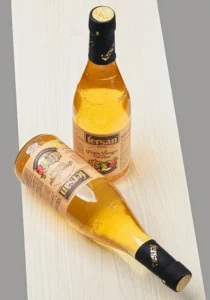You may have heard that people regularly add vodka, vinegar, or even sugar to their reef tanks to control excess nutrients. That may seem unlikely and even dangerous but it actually works!
It’s called carbon dosing…
Table of Contents
What Is Carbon Dosing
First up, what it is not. Carbon dosing should not be confused with adding activated carbon to your filter. That is designed to filter out pollutants and improve water clarity.
Carbon dosing is a method to help control excess nitrates and phosphates in a reef tank.
It works by feeding the good beneficial bacteria in the tank so that this bacteria multiplies and therefore consumes more excess nutrients, primarily nitrates and phosphates.
An excess of nitrates and phosphates can lead to algae problems, poor coral growth, and other problems.

Getting Started With Carbon Dosing
First, carbon dosing should only be considered with a more established reef tank that has been running for at least 6 – 9 months.
It’s also important that you are regularly testing your tank for the levels of nitrates and phosphates.
See our guide on the Best Test Kits for a Saltwater Fish Tank to help you do this.
If you are finding that, even with regular water changes, your levels of nitrates and phosphates are elevated you may wish to consider carbon dosing.
Be aware that the main problem with adding carbon is overdosing. This can cause the beneficial bacteria population in your tank to explode, completely stripping your tank of needed nutrients.
In extreme cases, this can also deplete the oxygen in the water to a level where it would be harmful to your fish, corals and invertebrates.
So, regardless of the carbon source you use, start slowly with small initial doses only increasing incrementally following rigorous testing of the levels of nitrates and phosphates.
You should also always run a protein skimmer when carbon dosing as it will remove any excessive bacteria and ensure good oxygenation of the water.
Sources of Carbon for Dosing
Vodka
Yes, the vodka that you drink. Vodka is basically ethanol (ethyl alcohol) and is a pure form of organic carbon that doesn’t contain any other additives or colouring found in other spirits.
Don’t buy a bottle of Absolut, Smirnoff or any other expensive brand. The cheapest bottle from your local supermarket will do fine just make sure it’s 40% alcohol content.
Start with a very small dose of around 0.1 – 0.2ml per 100 litres of water volume. Closely monitor your nitrate and phosphate levels and increase or decrease the dose as required.

Vinegar
No, don’t use a fancy flavoured vinegar or even the one you use on your fish and chips. It’s best to use plain basic white (or clear) vinegar that you can buy in bulk online or at some or the larger supermarkets.
The acetic acid content of vinegar can vary but for dosing you want the concentration to be around 4 to 6 %.
As vinegar contains around 8 times less carbon than vodka the starting doses will be higher at around 0.8 – 1.6ml per 100 litres of water volume. Again, closely monitor your nitrate and phosphate levels and increase or decrease the dose as required.
Carbon Dosing Supplements
As you would expect, there are a number of carbon dosing supplements available on the market such as Red Sea’s NoPox which is “a unique complex of carbon substances and other organically bound elements that enhances the activity of nutrient reducing bacteria”
We have used NOPox and it does what it says on the tin, successfully reducing nitrates and phosphates. However, when compared to using vodka or vinegar it is very expensive at around £30 – 35 per litre.
DIY Carbon Dosing Recipe
Having done some research around marine aquarium forums for a DIY carbon dosing recipe we settled on the following formula to create our own carbon dosing supplement.
To make up one litre of dosing solution:-
- 500ml of vinegar (5% acetic acid content) +
- 375 ml of vodka (40% alcohol)
- 125 ml RODI water.
As a rough guide for using this solution, these are the recommended doses depending on your nitrate level:-
| Measured Level (ppm) | Daily Dose ml/100 L |
| NO3 above 10 | 3 |
| NO3 above 2.5, but less than 10 | 2 |
| NO3 above 1 but less than 2.5 | 1 |
Use a Dosing Pump
Of course, you can dose any of the above solutions manually but we’d recommend letting a good dosing pump take the strain.
See our guide on the Best Dosing Pumps For Reef Tanks to help you make the right choice.
Carbon Dosing FAQs
Does carbon dosing remove nitrates? – Yes, adding a carbon source feeds the beneficial bacteria that consume excess nitrates. Dosing carbon on a daily basis helps to control the level of nitrates in a reef tank.
Does carbon dosing reduce phosphates? – Yes, carbon dosing feeds beneficial bacteria that consume excess nitrates and phosphates.
Does carbon dosing lower PH? – Carbon dosing can reduce the amount of oxygen in your tank which will, in turn, affect PH. You should closely monitor PH levels when carbon dosing.
Why dose Vodka in a reef tank? – Vodka contains ethanol (ethyl alcohol) and is a pure form of organic carbon. Added to a reef tank it helps feed beneficial bacteria that consume excess nitrates and phosphates.
